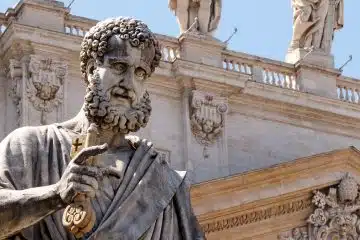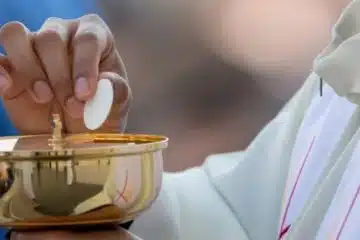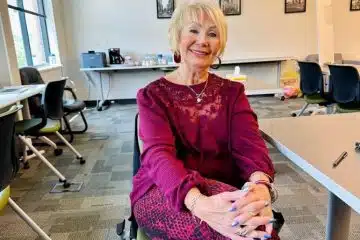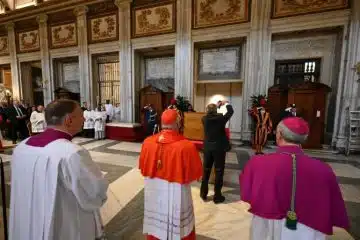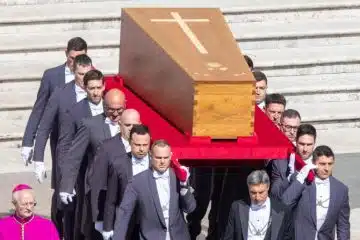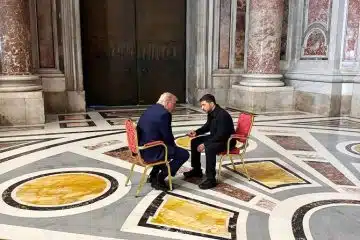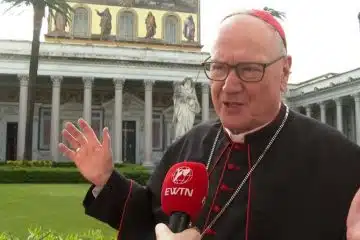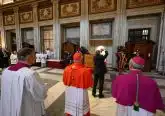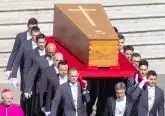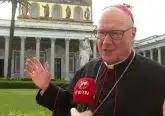Circuitous route led to director’s second film on exorcism

IMAGE: CNS photo/The Orchard
By Mark Pattison
WASHINGTON (CNS) — Sometimes the best opportunities result from a mix of asking and having things fall into your lap.
So it was for William Friedkin, who directed “The Exorcist” 45 years ago and thought he was through with the subgenre he helped create. Then came his documentary on exorcism, “The Devil and Father Amorth.”
“It was a complete accident,” Friedkin told Catholic News Service in an April 16 interview in Washington to promote the film. “I had no intention of doing this. I had no interest. ‘The Exorcist’ was a work of fiction. I had never seen a real exorcism, and neither had William Peter Blatty,” who had written the novel on which that movie was based.
Friedkin said he had been in Luca, Italy, to receive the Puccini Prize for having directed four Puccini operas. He soon heard Pisa was a 35-minute drive from Luca, so he made the trip. Then he learned it was a one-hour flight from Pisa to Rome. Given that he had eight days in Italy, he wrote a priest-theologian friend, and “as a lark, I asked, ‘Do you think I could get a meeting with the pope or Father (Gabriele) Amorth?'”
The reply: “The pope’s not available, but Father Amorth would be very pleased to meet you.” The desired meeting took place between Friedkin and the priest whose skills in performing exorcisms he characterized this way: “There’s exorcists and there’s exorcists, like there’s basketball players and LeBron James.”
Friedkin returned to Los Angeles and was at the Vanity Fair magazine post-Oscars party when he told then-editor Graydon Carter of his meeting with the priest. Carter urged him to write an article about Father Amorth. Before making a return trip to Rome he wrote the priest, who answered only in longhand. “I pushed my luck,” Friedkin said. “Would you ever let me witness an exorcism?” “Let me think about it,” Father Amorth said; eventually, his order, the Pauline Fathers, gave permission for him to see an exorcism on a specific date — May 1, 2016.
“I pushed my luck again, and I wrote back, ‘Do you think he would allow me to film it?’ The word came back in two days, that yes, he would allow me to film it, but alone with no crew and no lights,” Friedkin said.
Friedkin’s filming of Cristina, the first known filmed exorcism, is what makes up the core of “The Devil and Father Amorth.” “I had been told by Father Amorth this was her ninth exorcism and she had experienced personality changes, vocal changes, and a kind of unnatural strength for a woman her size and age,” he recalled. “So I was aware from him this was going to happen — to what extent, I didn’t know.”
He said he was surprised by how “disturbing the (demonic) attacks were. I went from abject terror sitting two feet away from her to absolute empathy for the pain she was expressing. She’s a wonderful woman. She’s an architect. You wonder how these attacks came about, why.”
Father Amorth, who was 91, died several months after the filming. The priest was chief exorcist of the Diocese of Rome from 1986 until his death in 2016. Cristina continues to seek help to cast out whatever demon is inside her with the help of other exorcists.
The movie also shows Friedkin talking with neurosurgeons and psychiatrists who have seen his exorcism footage who seem at a loss to either debunk or explain it.
More attention to Father Amorth “would have helped to offset the inevitable grimness of the rite at the heart of the proceedings,” said John Mulderig, CNS assistant director for media reviews, in his review of “The Devil and Father Amorth.” “At times, Friedkin appears slightly breathless with enthusiasm for his own material, and Christopher Rouse’s churning score also hints at sensationalism. But overall, the tone is respectful and sober-minded.”
The film is classified A-II — adults and adolescents — for mature themes, potentially disturbing images and a rude gesture.
“Father Amorth said to me the devil is metaphor,” Friedkin told CNS. “The devil is not some figurative person, although he did say that he has had conversations with Satan. But he said there is no figure as he’s been depicted. He believes that the devil is metaphor. I 100 percent believe there is evil in the world — every day, all day, constantly — but there is also a great goodness.”
Friedkin, who was raised Jewish, now embraces faith in a different way.
Although he is not a Catholic, “I strongly believe in the teachings of Jesus — strongly believe in the teachings of Jesus — and I don’t necessarily require the supernatural to believe in Jesus,” he said, referring to the Resurrection.
Friedkin said his aims with the documentary are modest. “Just a sharing of information, which is what any filmmaker — especially if you make a documentary — experience. ‘Here. this is what I saw,'” he said. “And what I’m saying to the audience, “Make of this what you will, but here it is.’ We live in a very skeptical world, so I expect a lot of that.”
– – –
Follow Pattison on Twitter: @MeMarkPattison.
– – –
Copyright © 2018 Catholic News Service/U.S. Conference of Catholic Bishops. www.catholicnews.com. All rights reserved. Republishing or redistributing of CNS content, including by framing or similar means without prior permission, is prohibited. You may link to stories on our public site. This copy is for your personal, non-commercial use only. To request permission for republishing or redistributing of CNS content, please contact permissions at [email protected].


